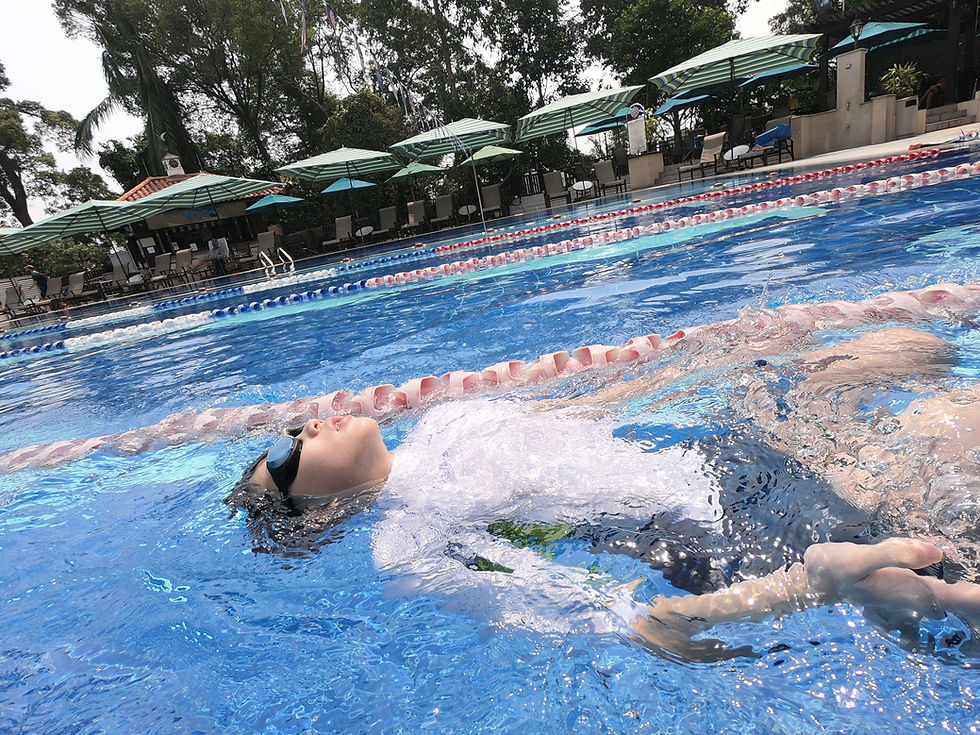Creating a Balanced Training Plan with Backstroke
- SG Sink Or Swim

- 23 hours ago
- 4 min read

Integrating the “Rest Stroke” into a Holistic, Sustainable, and High-Performance Program
Backstroke is often called the “rest stroke” — but for those who race it, coach it, or rely on it for fitness, it’s anything but passive. With its unique demands — body rotation, blind turns, hip-driven kick, and precise timing — backstroke requires dedicated attention in any well-rounded swim program.
Yet too often, backstroke is an afterthought: tacked onto the end of freestyle sets, neglected in favor of butterfly sprints, or used only as recovery. The result? Imbalanced development, shoulder strain, and missed potential.
A truly balanced training plan doesn’t just include backstroke — it integrates it strategically to build symmetry, prevent injury, enhance overall performance, and keep swimmers engaged.
In this guide, we’ll show you how to design a training program where backstroke isn’t the side dish — it’s a core component of success.
🎯 Why Backstroke Belongs in Every Balanced Plan
✅ Promotes Muscular Balance
Freestyle and butterfly emphasize internal rotation and chest dominance
Backstroke engages lats, rear delts, and external rotators — counteracting imbalances
Reduces risk of shoulder impingement and overuse injuries
✅ Builds Core Stability & Body Awareness
Controlled rotation teaches core-driven movement
Swimming “blind” enhances proprioception and spatial awareness
✅ Enhances Overall Stroke Efficiency
Strong backstroke = better body line in all strokes
Flip turn proficiency transfers to freestyle and butterfly
✅ Supports Recovery & Active Rest
Low-impact, face-out breathing makes it ideal for aerobic base or cooldown
Maintains fitness during shoulder rehab or high-fatigue weeks
📅 The 4 Principles of a Backstroke-Balanced Plan
1. Dedicate Specific Backstroke Volume
Recreational Swimmers: 20–30% of weekly yardage
Competitive Swimmers: 25–35% (higher for backstrokers)
Masters/Adults: At least 1–2 dedicated backstroke sessions/week
💡 Example: In a 4,000m workout, include 1,000–1,400m of purposeful backstroke.
2. Vary the Focus: Technique, Endurance, Speed
Don’t just swim backstroke — train it with intention.
Technique | 6 x 50m 6-Kick Switch + Catch-Up |
Endurance | 5 x 200m @ threshold pace, negative split |
Speed | 8 x 50m @ race pace, 30s rest |
Turns | 10 x 25m flip turn sprints |
3. Pair Backstroke with Complementary Strokes
Use backstroke to create balance in IM and mixed sets.
✅ IM Order Sets:
4 x 100m IM — builds transition fluency
3 x 200m Back/Breast — balances upper/lower body focus
✅ Recovery Sets:
After hard freestyle: 400m easy backstroke
Between butterfly sets: 200m backstroke to open chest
4. Prioritize Turns and Breakouts
Backstroke turns are race-changers — and often neglected.
Dedicate 10–15 min/week to turn-specific work
Drill: “Wall-to-Wall Streamline Glides” + “5 UDK Breakouts”
Film turns monthly — check for legal, fast execution
⚠️ Rule Reminder: Must touch on back — no early rolls!
🏊♀️ Sample Weekly Balanced Plan (Competitive Swimmer)
Mon | Technique + Turns | 8 x 25m flip turns; 4 x 50m 6-Kick Switch |
Tue | Threshold (Free/IM) | 4 x 100m IM — back leg focus |
Wed | Recovery + Dryland | 600m easy backstroke + core work |
Thu | Race Pace | 6 x 50m back @ 95%; 2 x 100m negative split |
Fri | Rest or Active Recovery | — |
Sat | Time Trial / Meet | 100m/200m back time trial |
Sun | Long Swim | 1000m continuous back/fly mix |
✅ Total Backstroke: ~1,800m/week — purposeful, varied, balanced
🧠 Stroke-Specific Drills for a Balanced Backstroke
🔹 6-Kick Switch
Builds rotation and side-body awareness
4 x 50m, 20s rest
🔹 Fingertip Drag
Reinforces high-elbow recovery
4 x 25m, focus on relaxed hand
🔹 Single-Arm Backstroke
Isolates pull and rotation
4 x 50m per arm
🔹 Tempo Trainer Sets
Locks in stroke rate for pacing
5 x 100m @ 1.5s/stroke
🔹 Underwater Breakout Sprints
Maximizes wall speed
8 x 15m, full recovery
⚠️ Common Imbalances to Avoid
❌ Only swimming backstroke as recovery → Misses power and speed development
❌ Ignoring turns → Loses 0.5–1.0s per race
❌ Swimming flat (no rotation) → Strains shoulders, reduces pull power
❌ Over-kicking → Wastes energy; kick should stabilize, not propel
💡 Fix: Treat backstroke like any race stroke — with drills, sets, and goals.
💬 Coaching Cues That Build Balance
🌊 “Rotate from your core — not your arms.”
🪵 “Be a log, not a noodle.”
🎯 “Shoulder to the sky, hip to the wall.”
⏱️ “Your turn is your weapon — sharpen it.”
💙 “Backstroke isn’t rest — it’s reset.”
🌟 The Bigger Picture: Backstroke as a Lifelong Stroke
For masters swimmers and fitness enthusiasts, backstroke is a gift:
Gentle on aging joints
Excellent for posture and lung health
Safe for solo swimming (face out of water)
Meditative and stress-relieving
Final Thoughts
A balanced training plan doesn’t mean equal time in every stroke. It means intentional inclusion — using each stroke to support the whole athlete. And backstroke, with its unique blend of power, precision, and peace, is indispensable.
So don’t relegate it to cooldowns. Don’t skip the turns.Don’t call it “easy.”
Give backstroke the respect it deserves —and watch your entire swimming transform.
Roll. Reach. Kick. Turn. Repeat.
Because in a balanced program, every stroke has its purpose —and backstroke is the anchor of symmetry. 💙🏊♂️





Comments